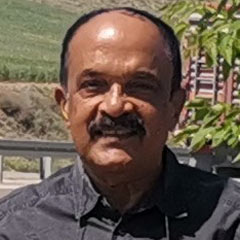One way of having a good time in Sri Lanka

Mail This Article
This is just one way. There must be so many other ways. The first thing we did was not to go looking for the ‘world’s tallest, biggest, oldest, grandest’ kind of sights, or the ‘world’s most exquisite’ food, in this lovely country. We went to Sri Lanka to enjoy the quietness and slow pace, the sunlight, the soothing tropical greenery, the people and the simple, tasty food. Whether it’s the beaches, the mountains or the plains, do not expect the ‘awesome’ experience. And the overall cleanliness is so cheering especially when you go from India.
Sri Lanka makes you happy by its unpretentious simpleness, homeliness and cordiality. It doesn’t invade or overpower you. It doesn’t make you feel that you’re up against a superior force. There’s nobody waiting to make you obey inflexible rules and keep you rushing headlong. It’s not expensive unless you choose expensive options. Sri Lanka’s ancient name was Serendip, from which came the English word ‘serendipity’, meaning the spontaneous happening of happy and beneficial things. For me Sri Lanka was just that - a place I could sink into, just float and let good things happen.

It’s hard to imagine that a terrible civil war had once swallowed this haven of peace. As you drive through the lush green of trees, plants, shrubs, forests, orchards, paddy fields, coconut trees, and hamlets where people lead their anonymous lives, violence seems an impossibility in such a paradise. But sadly, the harshness of majoritarian politics produced a counter-violence which perhaps became more brutal. At the end of it all, according to United Nations estimates, around 40,000 innocent women, children and men lost their lives. Some sources put the figure at 70,000. Memories are alive. On May 17, 2025, as we drove through areas that were once raging battle fields, at several places people were conducting rites for the dead. Because the next day was the 16th anniversary of the end of the civil war on May 18, 2009. The war had lasted 26 years, devastating this idyllic nation.
We – my friends Madhu Nair, Gouridasan Nair, V Sashi Kumar and myself - had travelled overnight from Thiruvananthapuram, Kerala, to Nagapattinam in Tamil Nadu to take the Subham ferry to Jaffna. We chose the ferry not only to get a feel of the sea crossing but also to beat the ruthlessly indiscriminate, unethical and extortionate flight prices. The Thiruvananthapuram-Colombo flight of around 30 minutes’ duration is charged upwards from a whopping Rs. 20,000 per head, whether return or one-way.

For the ferry, the price of a one-way ticket is Rs. 4500 per head (as on May 15, 2025) and it’s a 4-hour journey. The crossing was pleasant and steady, through a calm, blue sea. The only disruptor of the wonderful quietude the dancing waves of the sea had bestowed upon us was the loud, rude, blaring of the movie on the TV screen. But lots of people were glued to it. We live in a democracy. My cup of tea isn’t theirs.
Let me warn you that the ferry option is for people with patience. It could be cancelled without notice – come to think of it, so do airlines – and the journey postponed, in our case to the next day. And, at least on the day we travelled, it started one and a half hours late. There’s considerable confusion at the Nagapattinam terminal which I thought was forgivable because it reopened only in August 2024 and facilities are yet to take shape. They manage with just two camp toilets on site. But somehow the staff kept things moving. And the courtesy in dealings eased the shortcomings. But I’m forced to say that the muddle at the Sri Lankan terminal was frightening. Obviously, they too are suffering from starting troubles. But the disorganisation was beyond belief. Just one detail: it took us over one and half hours to get our luggage. You’re worn-out and tense as you exit the terminal. Perhaps Sri Lanka places ferry passengers somewhere at the bottom of their tourism priorities.

We had arranged for a car and an English-knowing driver for our 6-day journey. Because, we wished to do a slow, relaxed crawl through the countryside, from Jaffna in the north to Colombo in the south-west, stopping here and there, looking at this and that, savouring Sri Lanka bit by bit. We got a spacious mini-van at reasonable terms and the service of a good, reliable driver. I shall not hesitate to mention the name of the car service – MySL Travel – because the service was indeed excellent. The young lady, Julie, who handled our trip from the administrative end was clear in her communication and pro-active. Each of the home-stays we had booked was clean, comfortable and hassle-free – we were not of course looking for luxury. If our brief experience of this trip was any indication, it’s no surprise that Sri Lankan tourism is doing so well – let’s forget the unfortunate ferry chapter.

Jaffna, where a terrible river of blood flowed during the civil war, is a beautiful colonial town, spacious, laid-back, with broad avenues, graceful houses and busy bazars. It’s beyond imagination that horrendous deeds had been perpetrated there. Apart from the killing of innocent people, a great institution was destroyed. The Jaffna Library with its 97000 volumes, precious manuscripts and rare historical records was burned down. To a quick visitor like me, it seems time has healed the wounds. It’s a city I would like to return to. It has a heart.
The journey from Jaffna to Anuradhapura took us – with diversions - through some of the most bitterly fought battle fields of the civil war, like Elephant Pass, Kilinochchi, Mullaitivu and Vavuniya. It was in these areas that we encountered people holding rites for the dead. They served us tasty rice-payasam in memory of their dear ones.
The little town of Anuradhapura is for Buddha enthusiasts. It’s a serene, understated town set in a maze of greenery. Its famous Buddhist monuments are scattered over a large area. A lover of Buddhist history can lose herself among them. For others Anuradhapura is yet one more carefree, easy place to relax, stroll around and just feel good.

Sri Lanka’s nature, at first look, seemed a replica of Kerala’s unending greenery for a person from Kerala. But there are differences. Tropical wild flora – innumerable varieties of trees, plants, creepers, shrubs, undergrowth, grasses – which Sri Lanka has in abundance, have more or less vanished from Kerala’s countryside. Sri Lankan villages are sparsely populated and set far apart from each other unlike Kerala’s seamless stream of populated areas. Roads are peaceful and quiet. There’s no one hustling you off the road or trying to overtake with horns blasting. You glide along under the shadows of the trees as if you’re the only one in that verdant world. Driving in Sri Lanka is a joy for the easy-going, relaxed driver.
On the way to Polonnaruwa we had a short camera-stop for the famous single-rock in Sigiriya. You can climb its 1200 steps, if you’ve the time and the energy, to explore the historic remains at the top. Polonnaruwa was the ancient capital of Chola and Sinhalese kingdoms. What is left today are hundreds of remnants of ancient structures, graves, stupas, temples and statues, spread over acres of parkland filled with trees. If you’re an archaeological enthusiast, it’s your pleasure-garden. Otherwise, you can stroll around the quiet town and have a good drink of Sri Lankan arrack, which to me is the best arrack at that moderate price. Let me not forget to add: Sri Lankan brandy too is equally good – lovers of cognac may kindly excuse.

Thus, onwards to Kandy, which is a fairy tale town set amongst tree-covered hills with a lake right in the heart of it. Now you’re in hill country. From here you can go up to the tea estates and hill stations that offer grand views and trekking, and certainly cool weather. The centre of Kandy town, around the lake, is a sculpted urban space, calm and clean. It’s clear that somebody with a sense of urban aesthetics planned the inner-cityscape.
The most famous destination in Kandy is the temple where the faithful can venerate Buddha’s tooth - faith is a mysterious thing. I expected a grand temple, but was pleasantly surprised by a graceful mansion, hardly glittering or exhibitionist, into which you can walk and simply merge into the crowd. There’s some jostling when the doors to the altar where the golden cabinet containing the tooth are opened. But the faithful are entitled to their enthusiasm and we happily joined them.
Finally, we are in Colombo. For those who love the very human commotion of cities like Chennai and Mumbai, Colombo is just the place. It’s crowded, vehicles and people are running helter-skelter and the faces that pass you are typically urban-tense. It’s obviously a workaholic city. Yet it’s a very human city, very enjoyable if you’re ready to savour a busy cultural melting pot - and want, like us, to do bargain shopping of nice things like sarongs in Fort Market or Pettah. Sadly, for the first time in our journey we encountered the lack of attention to cleanliness in Colombo.
Ours was a one-dimensional trip tailored to suit our budget and interests. We didn’t, for example, touch the beaches which have a great reputation; we altogether left out the East and its wild life parks, the South and Galle, the historic town. That would’ve rounded off our Sri Lankan experience. We cherish what we managed to do. We returned happy, relaxed and with wonderful memories.
Paul Zacharia is a well-known Indian writer and columnist.




